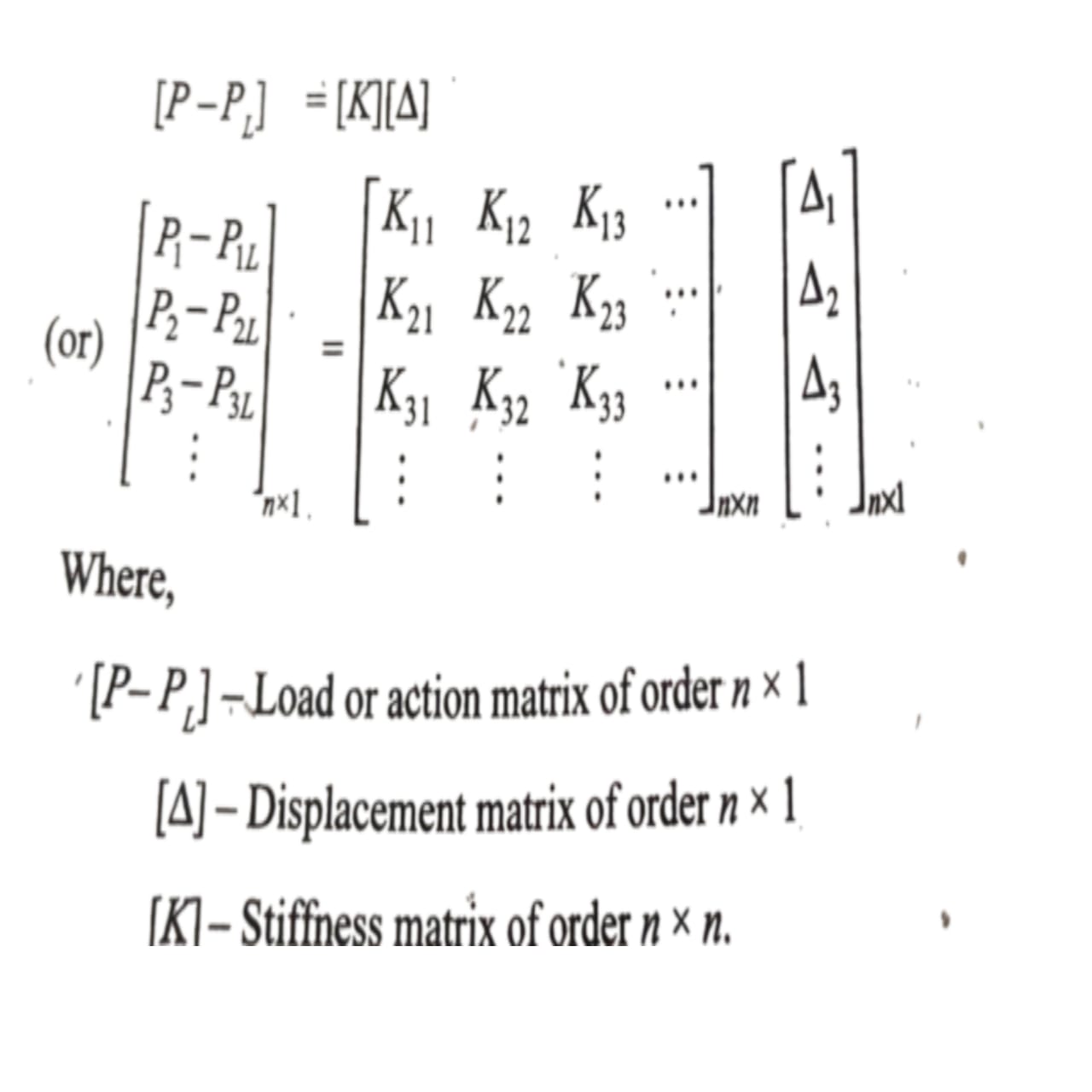Stiffness Matrix method
Stiffines matrix method is the matris which is generated by the systematic development of slope deflection method in matrix form When a structure has number of coordinates, the response of its force towards the displacement is shown by,

The basic unknowns in this method are the displacement of joints. In order to generate stiffness matrix, apply unit displacement as the coordinates and evaluate the forces developed at all other coordinates due to the application of unit displacement. Slopes and deflections are obtained at the joints by solving the equilibrium equations. Stiffness matrix method is also known as displacement method or equilibrium method
1.It is a systematic development of slope deflection method of structural analysis.
2. In this method, the basic unknowns are displacements (either deflections or rotations)
3. Degree of kinematic indeterminacy is required to find the number of co-ordinates.
4.Equilibrium conditions are formed for analysis.
5. An element (say K) in stiffness matrix represents the force at co-ordinate “i” due to the application unit displacement at co-ordinate ”.
6. Stiffiness matrix has diagonal symmetry ie.. K_{2} = K_{2}
7. The forces in the members of beam or structure are evaluated using the slope deflection equations.
8. Stiffness method follows a step-wise procedure and hence it can easily be convertible to a computer program.
9. Less or minimum computations are involved in the process of development of the stiffness matrix
The step by step procedure to be followed in stiffness method of analysis of structure is,
1.Determine the kinematic indeterminacy (or) degree of freedom of structure
2.Based upon the kinematic indeterminacy, slentify the threction and location of displacements at the joints and assign coordinates to than
3 To avoid displacements at the jounts ie, to develop a fully restrained structure, apply restraining forces at the coordinates. 4.Determine the restraining forces, Restraining forces are nothing but the sum of fixed end moments/forces of all the members meeting at the joint. They are denoted by lfloor P_{i}
5.develop the stiffness matrix [X] by successively applying unit displacement to the restrained structure at all the coordinates one-by-one and evaluate the forces developed at all the coordinates, as a result of application of unit displacement at the particular coordinate. Stiffness matris is represented by [K] Suppose, it degree of freedom =2; then,
6.Determine the final forces in various directions of coordinates. Final forces are represented by [P].
7.Evaluate the forces in the members of beam by substituting the evaluated values of displacements at joints in slope-deflection equations
Following are the reasons to prefer the stiffness matrix over flexibility matrix:
1.Stiffness method is preferred over flexibility method when the structure is to be analyzed using computer programs.
2.The procedure of solving the stiffness matrix is unique and it does not depend upon the user for choosing the primary structure.
3. Stiffness method is preferable for analysing large structures, as each and every step involved in this method can be performed by the computer more easily, when compared to that of force/flexibility method
4. Time required to develop stiffness matrix in stiffness method is less when compared with the time required to develop flexibility matrix in flexibility method.
5. Computational effort required in stiffness method of analysis is less when compared to flexibility method
6 Stiffness method of analysis is more occurate and simple when compared to flexibility method
stiffness method for analyzing statically indeterminate structures
Stiffness of a joint is defined as the force required at the coordinate due to a unit displacement at the coordinate, while preventing displacements of all the other joints.
In stiffness method, the first step in analysis is the determination of degree of kinematic indeterminacy. Coordinates assigned to the unknown displacements. Next step in the analysis is, the development of stiffness matrix. For developing the stiffbes matrix, a unit displacement is first given at coordinate (1) while making the displacements of all the other coordinates “zero”. The displacements at the other coordinates are The relationship between the stiffness, forces and displacements at coordinates is given by,

The elements of stiffness matrix along the principal diagonal are known as direct stiffness coordinates and the remain elements are called as cross stiffness coefficients
